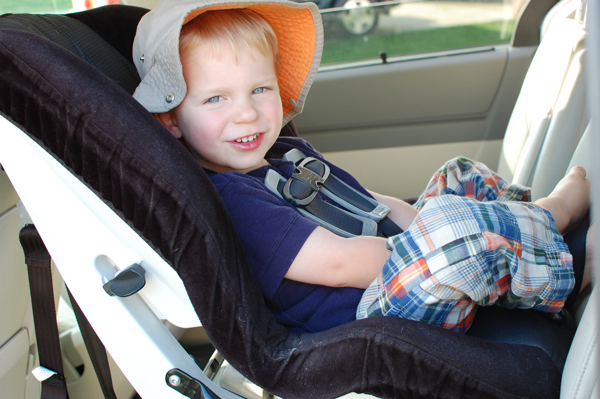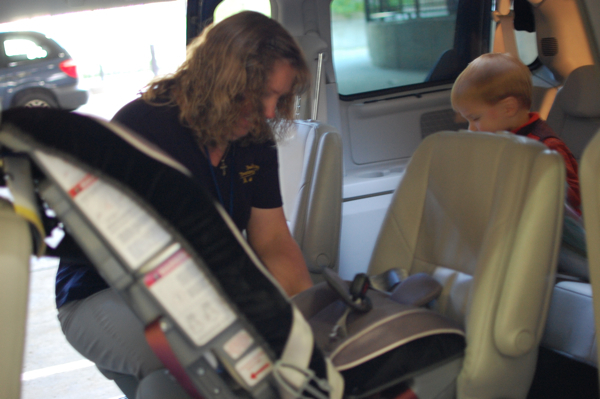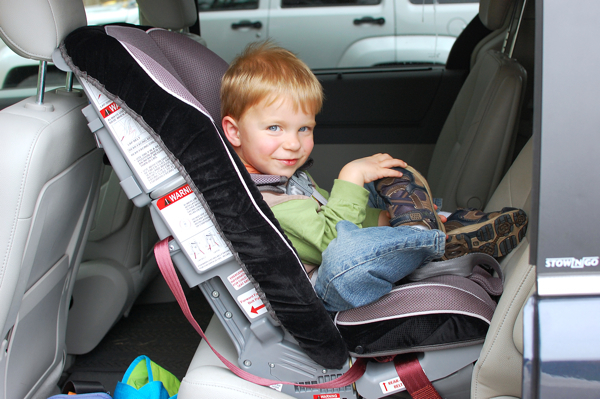Our extended rear facing toddler.
Our 33 pound, three year old little boy, is still safely tucked into in a rear facing convertible seat whenever he is riding in a motor vehicle. This is not popular culture, and we know it. If we didn't know it before, the amount of commentary we've received from the peanut gallery has certainly brought it to our attention.  But we believe that the information available says this is the safest way for him to ride, and like most parents we are committed to keeping our child safe. So why does extended rear facing (ERF), though gaining in popularity, remain purely a counter-culture movement? I'm sure there are a lot of reasons, but a failure to circulate important facts, coupled with general confusion, is probably the biggest culprit. As new first time parents we knew nothing about ERF, but when it came time to buy a new carseat, careful online research introduced us to the movement, and further research won us over. This is a site about child development and learning, and this is a post about child development, and about learning—it's about what we learned regarding ERF because we think it's a really important issue.
But we believe that the information available says this is the safest way for him to ride, and like most parents we are committed to keeping our child safe. So why does extended rear facing (ERF), though gaining in popularity, remain purely a counter-culture movement? I'm sure there are a lot of reasons, but a failure to circulate important facts, coupled with general confusion, is probably the biggest culprit. As new first time parents we knew nothing about ERF, but when it came time to buy a new carseat, careful online research introduced us to the movement, and further research won us over. This is a site about child development and learning, and this is a post about child development, and about learning—it's about what we learned regarding ERF because we think it's a really important issue.
The CDC ranks motor vehicle accidents as the leading cause of death in young children, but car seat safety can be a rather confusing topic for many new parents. State laws require that an infant remain in a rear facing restraint system until they reach one year of age and 20 pounds in weight, but many parents read this either as a mere suggestion, or as an either/or option, turning their children around when they reach 20 pounds before their first year, or vise versa. And the confusion extends way beyond the first year—the AAP says that we should keep our kids rear facing for as long as their convertible car seat will allow, but not all its member practices seem to be aware of this. At Calvin's one year appointment the RN who welcomed us was actually apalled that we planned to keep him rear facing for as long as possible and I had to remind her that we were complying with AAP recommendations. This is in stark contrast to the RN who, just last week, did the installation check on our new car seat and commended us on our ERF decision. If the medical professionals we trust can't even straighten it out, is it any wonder that it's a confusing issue for parents?
So why is rear facing so much safer? Simply put, kids aren't built like adults. In fact, a child's cervical vertibrae do not reach maturity (or ossify) until some time between their third and sixth year. Add to that the fact that a child's head is a greater percentage of his body weight, and you've got a rather precarious situation. If the forces in a crash are great enough, that relatively large head can be thrust forward, putting undue stress on the immature vertibrae and leading to spinal damage, sometimes even to internal decapitation and death. Still tempted to submit to the "well everyone does it" line of the popular culture gurus? Sure, most people do turn their kids around at one year, and a rare few of those are the reasons we have such horrendous factoids to share. I don't want to belong to that club. Besides, not everyone does do it.
The Swedes are well known as forerunners in the car seat safety department. In Sweden the unusual thing would be to turn your child forward facing before the age of three, and it is common to keep them rear facing to the age of five (55 pounds being the usual upper weight limit for rear facing on Swedish car seats). Based on the crash data coming from Sweden, at least one current study says the U.S. should recommend that children remain rear facing until the age of four, and that manufacturers of U.S. car seats should begin making seats with higher weight limit restrictions to accomodate this change. Some manufacturers have already responded to these demands, and have increased rear facing weight limits to 40 pounds or more. The seat we just bought for Calvin (the Sunshine Kids Radian 80SL) will allow him to remain rear facing to 45 pounds, and when we do turn him around it will keep him in a five point harness until he is 80 pounds (that's a conversation for another time, though, or you can read more about long term usage of a five point harness on the Kyle David Miller site).
That's my two cents, for what it's worth. You'll see where, in some cases, I've linked the original source of the data I am referencing. Other tid bits I've left unlinked because they are more widely discussed throughout the internet. For more information visit Car-Safety.org, where you'll find a great break down of the anatomy of a vehicular crash (though their car seat data does not reflect the most recent line of seats) and a forum where you can talk to safety technicians and other parents. Or visit the Kyle David Miller Foundation, where you'll find a page that really explains the medical support for ERF in clear terms, and several heart wrenching stories and videos.
 One last thing. Regardless of your stand on the issue, keep in mind that a car seat isn't safe, rear or forward facing, unless it is installed and used properly and is a good fit for the car. If you have any concerns about your seat installation, or even if you don't, do an internet search or call the nearest pediatric hospital to find a car seat safety technician (CST) and set up an appointment to have the installation checked. They can also answer lots of questions and give great tips (like don't buckle your child into the seat wearing a coat!), and check your daily usage. Calvin and I did this just last week and I even though I was sure things were fine (and they were) I feel much safer having had it checked.
One last thing. Regardless of your stand on the issue, keep in mind that a car seat isn't safe, rear or forward facing, unless it is installed and used properly and is a good fit for the car. If you have any concerns about your seat installation, or even if you don't, do an internet search or call the nearest pediatric hospital to find a car seat safety technician (CST) and set up an appointment to have the installation checked. They can also answer lots of questions and give great tips (like don't buckle your child into the seat wearing a coat!), and check your daily usage. Calvin and I did this just last week and I even though I was sure things were fine (and they were) I feel much safer having had it checked.
Ride safe.
 child development
child development 







Reader Comments